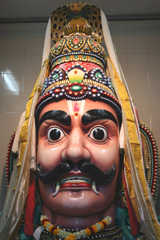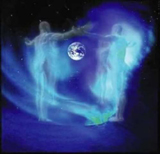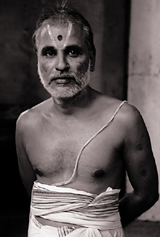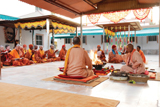Case study
Integrating a multi-faceted approach
Abstract
A young girl exhibiting multiple episodes of abnormal behaviour, after a shocking experience near a village deity, underwent treatment by multiple means. No single treatment modality could cure her completely but each one of them had a role in her recovery. She was open to spiritual influence and that helped a lot in her self-healing along with conventional treatment.
K , a 16-year-old girl had finished her matriculation exam and went for vacation to her native place in rural Andhra Pradesh. She was spending her time happily watching TV and meeting relatives. One fine morning, on 26th March 2015, her mother noticed something unusual about her behaviour. She was making some peculiar facial expressions. After some time, she started crying and continued throughout the day. On enquiring she kept on repeating only two sentences: “I am seeing black” and “Why are you crying?” She remained drowsy throughout the day. There was no improvement in her condition the following day either. Her relatives suspected black magic and took her to a local shaman who carried out some rituals on her and charged some money. However, there was no improvement in her condition. She continued to feel drowsy and kept on making gestures. Her brother, who has just completed his B Tech degree, was informed of this. He had been practising sādhanā and had a deeper understanding of the human mind and life from an Integral Health perspective.
After coming to see his sister on 29th March 2015, he decided to take her back to Odisha. Instead of consulting a psychiatrist he preferred to visit his spiritual guide who was also a doctor following the principles of Integral Health. His sister managed to attend a discourse conducted by this guide without creating any problem. In fact, later she willingly swept the hall. After the class was over, she came with her mother and brother to meet the guide but she started showing the same features and repeated the same words, “I am seeing black, why is everybody is crying?” She was not willing to answer any questions. When the guide wanted to meditate over her, she wanted to lie down and close her eyes. As she was not responding to any command, it was decided that the entire family would spend some time with the guide at his working place. The next morning she travelled along with him in the same vehicle for four hours and during at that time, the guide tried to invoke peace into the atmosphere. During the course of this drive, she became better and better and her gestures reduced. After reaching the destination, she was asked to see the homeopathic doctor who looked after the Integral Health Centre.
Surprisingly, she started speaking normally like someone with a stable mind. She reported that she had beenexperiencing tremors in her hands and legs and pain all over her body. She had been unable to speak at that time and had pain around the top of her head. She could not stop crying. She had developed a fear of thecolour of black. She experienced shivers on seeing anything black. This was creating an unpleasant mood in her. She could not even bear the thought of anything black. She said that she had been to her relative’s house two days before this episode. On the way she crossed a place where villagers offer their worship to a local deity. However, she did not offer any prayer and walked off. She distinctly felt the presence of a dark entity at that place. This was enough to shock her. As soon as she left, a sense of unease and discomfort had entered her mind. She was afraid of that dark entity and could not sleep. From the next day, she began crying over everything. She felt that the deity was angry with her and would curse her.
She also revealed that from childhood she had been chanting the Gayatri Mantra and had wanted to take initiation. But this had not happened for some reason or another. She felt it to be a major shortcoming in her life. In her personal life, she was never very comfortable with her friends who spent time gossiping among themselves and especially about love affairs.
She was constitutionally very thin. Her menstrual periods were irregular. Her thyroid function tests were altered, but she was not on regular treatment for that. During this episode, her appetite and thirst decreased. Her sleep became disturbed and she felt drowsy.
Homeopathic analysis
She listened to the doctor calmly but answered very slowly. She always had the feeling that she was a sinner as she had not taken initiation. She liked to pray and chant the Gayatri Mantra but did not get the desired relief always.
1. Rubric religious mania
2. Fear of black ghosts
3. Weeping
4. Cold hands and feet
5. She believed in following the doctor’s advice
6. She wanted to escape from the situation.
After analysing the above points, she was asked to pray.
She was also given a dose of the homeopathic medicine, Lachesis-200/ 1 dose.
She was reviewed after a day. She reported that she had experienced a sound sleep and felt well. Her shyness had disappeared. She took her food normally and asked what more she should do.
After 2 days she was advised to take Staphisagria 200 OD for 7 days. This was to be repeated after a gap of 15 days. She was also given Kali Phos 6X 4 tabs tid and was asked to increase the power at 2 months intervals from 6X to 12X, then 30X, and finally 200X.
She returned to her parents in western Odisha and continued to do well for the next 15 days. However, she got a violent attack again and once wanted to commit suicide. Every noon 3 to 4 people were summoned to hold her back from running towards the river. At that time she was very afraid, especially of the darkness.She did not want to talk, did not sleep and had become extremely restless. She was taken to another homeopath who prescribed CocculusIndica Q, Ceanothus Americana, Staphisagira 200 and Carbo Veg 30.
She calmed down a bit and had normal sleep. However, her condition got worse again after three days and it was noticed that she was deteriorating at the time of noon. She was becoming violent and eating mud. She was also deliberately putting water, rice and mud into her ears. The only thing that calmed her down was chanting the Gayatri Mantra, on her own or with her brother.
In this situation, she was taken to a psychiatrist who started her on Risperidone 2 mg (along with Trihexyphenidyl as an adjunct) twice daily with Lorazepam 2mg at bedtime. These medications reduced her symptoms partially but she became drowsy. As there was a considerable bitter aftertaste and because she felt a heavinessin the head, she was not keen to continue with the medicines. She was becoming normal after sometime after chanting the Gayatri Mantra but it was very difficult for her to persist with this in her drowsy state.
As her condition did not improve further, she was taken to another healer who cured snakebites by herbal remedies. This person had been well known to the family members for many years. He gave her a few roots to tie around her arm and some oil for massage as she was complaining of frequent body pain. He also advised her to visit a few temples every week. This had a wonderful impact on her. It was observed that whenever she was visiting a temple and was able to chant the Gayatri Mantra with great concentration, her condition improved a lot. However, she needed medication, either psychiatric or homeopathic, along with this. She preferred homeopathic remedies although they were not sufficient in tackling the acute episodes. On the whole, medication and meditation were found tocomplement each other.
At present she is almost normal. She does her chanting and her temple visits, takes her homeopathic medicine daily although the psychiatric medication is kept in reserve foremergency situations. She reported to the guide that during these attacks she was helpless and she felt as if she was possessed by another entity. She wants to visit the guide as soon as possible. She feels that the first session without any medication and intervention had given her the maximum level of peace and stability. But she has been warned that the condition could recur anytime and she has to keep watching her inner state.
Analysis
Disease is disharmony. This disharmony can be in the physical, vital, mental or spiritual levels and whatever brings in harmony can improve the condition.
In this case, physical disharmony was not so apparent except for her poor health, mild thyroid imbalance and sensitivity to the sun. However, she responded partially to Risperidone, which suggested that there was a chemical imbalance in the brain responsible for the expression of the illness. This intervention is purely on the physical plane. Its advantage is that it will act immediately and can be very useful in emergency situations. But it may not address the other dimensions of the disease. Moreover, psychiatrists are available only at urban places and medical colleges which are not easily accessible for rural patients.
Homeopathic remedies work on the vital plane as they manipulate the vital force. This patient had a gross imbalance in vitality as had beenevident in the drowsiness of the first episode and the violent rage during the second attack. After each attack, she used to become very weak. These remedies might have made some contribution at bringing peace into the vital plane. The costs were less and the physicians were available. But they could not control the violent episodes. Homeopathy still remains the mainstay of medical treatment in this case.
This patient was taken to shamans twice. The first, a local priest from Andhra Pradesh during the initial attack had been found. He was rustic and rough and there were no results. The second priest was gentle and usedhis traditional rituals, but again could not bring about any results during the second attack. It shows that despite the lack of results these practices are still prevalent in rural India due to lack of education and awareness.
However, the third priest, who did not take any money, was known to the patient and was very sympathetic. He used many herbs in different forms and provided her a routine of visiting three temples. He was successful in reducing her need of psychiatric medication and brought her back to normal like with the first healing episode. However, his approach was more psychological and spiritual. It was useful when the patient had faith and was open to his suggestions.
The most interesting part of the management was with the spiritual dimensions. She had first experienced this decline after crossing a local deity to whom she did not pay any attention. The only explanation can be the influence of the subtle entities of this place. On the first contact with the guide, the patient was drowsy, crying and afraid of anything black. She was not in a position to co-operate. The only thing done by the guide was to establish an atmosphere of intense peace and silence during the travel for four hours. It could bring back the patient to a normal condition and subsequently she responded favourably to homeopathic remedies. However, when the patient went back to her parents the guide could not influence her due to the distance. The medium available was her brother who was advised to do the same and bring peace into the atmosphere. It was not always possible for him to maintain the poise due to physical exhaustion and inner disturbances. But she responded well when he encouraged her to perform the japa of the Gayatri Mantra and thereafter she increased her chanting. Only a day or two earlier during the acute episode she was trying to avoid her brother. It was observed that when her brother was in a condition of peace and silence, it had a calming effect on the girl. She even responded to a simple touch. It suggests that the patient could create her own healing force by chanting the Gayatri Mantra as she could connect with her own inner source of harmony with this mantra.
Conclusion
This case explains the relevance of an integral approach to treatment where not only modern medicine, but also alternative therapies, psychological means and spiritual means each have a role to play. In the usual situation, cases like this suffer a lot with local priests and shamans who neither have any goodwill nor any skill. Those who are a little more educated go straight away for psychiatric treatment, which is relatively costly and may not cater to the entire needs of the patient. Prolonged psychiatric treatment is a stigma in most sections of Indian society, particularly for a young, unmarried girl. This adds a lot of worry to the parents and relatives.
In this integral approach, there was an underlying faith and patience instilled into the relatives. She was observed meticulously and given minimal medication when the severity of the attacks increased. Hence we could avoid the unwanted side-effects of medication. Homeopathy was a special addition, which many people would not consider effective for psychiatric cases. In this case, it may have contributed, along with the spiritual processes, in stabilising the patient. Psychological tools like prayers and healing sessions with priests worked in boosting the confidence and faith of the patient. The foundation for success in this case was the consciousness of the patient, which could open continuously to spiritual influences. During the acute episodes too, she was trying to chant the Gayatri Mantra and attempting to talk to the guide over the phone. This opening in her consciousness allowed the guide to proceed slowly in the management without any sense of panic from family members and with appropriate intervention in multiple modalities.
By the end, the patient has recovered from these episodes with a greater clarity about her physical, mental and vital weaknesses as well as a spiritual strength to manage her condition. She is a much stronger person now. The whole disease episode has opened up the possibility of an inner growth in her. She wants to join an ashram and pursue her inner yearning, which she feels will offer a life better suited to her. However, it has been made clear to her that these episodes could recur as we have not discovered the primary source of the disharmony. Her parents now understand that it is useless spending money with shamans who claim to remove wrong influences. They have also realised the value of peace, prayer and patience in improving psychological abnormalities along with medication.
Dr.DebabrataSahani, who runs a centre for integral eye care and research at Keonjhar, Odisha, lives and breathes the many facets of Integral Health.
Share with us (Comments,contributions,opinions)
When reproducing this feature, please credit NAMAH,and give the byline. Please send us cuttings.







